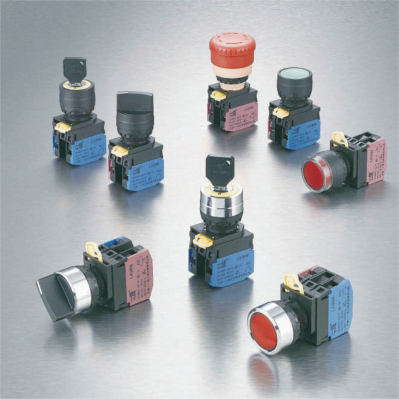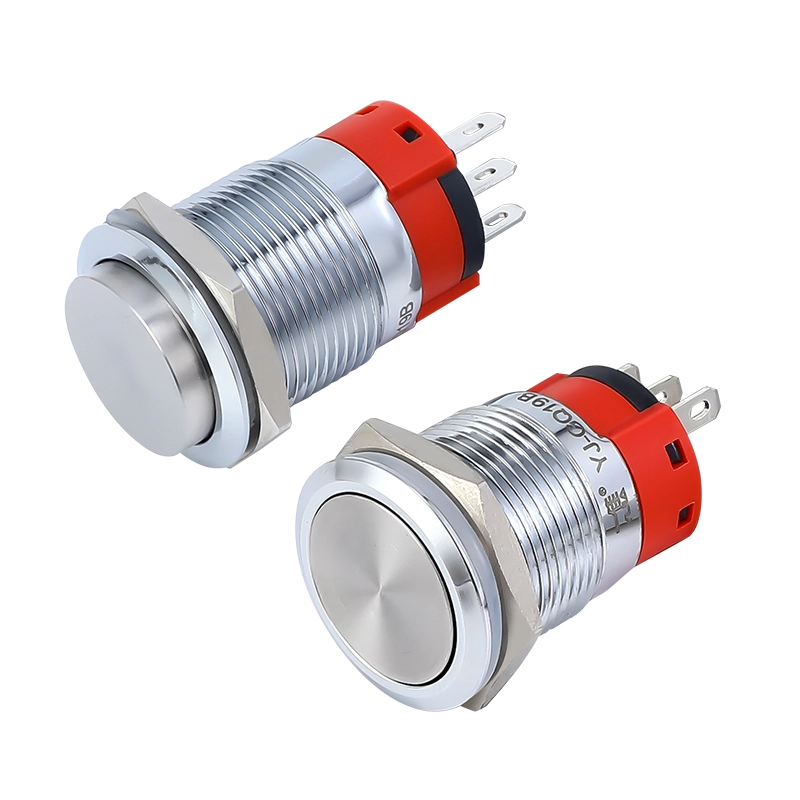Single Pole Single Throw Push Button Switch
SPST push button switch structure
The single-pole single-throw (SPST) push button switch is a simple switching mechanism whose structural design enables it to control the on and off of a circuit. The SPST button switch mainly consists of the following parts:
- Button (Actuator): This is the part that users directly contact and operate. When the button is pressed, it triggers the switch action to close or open the circuit.
- Contacts: These are the electrical contacts inside the switch that are responsible for completing the connection or disconnection of the circuit. In an SPST push button switch, it usually contains a set of fixed contacts and a set of movable contacts, which move with the button operation.
- Housing: Usually made of plastic or metal, it is used to protect the internal electrical components from the external environment and ensure the safety of users.
- Terminals: These are the parts of the switch that connect to the circuit. In a SPST switch, there are usually two terminals, one for input and the other for output.
- Spring: In many SPST push button switches, the spring is used to allow the button to return to its original position after release, restoring the switch to the on state.
working principle
The working principle of a single-pole single-throw (SPST) push button switch is relatively simple. It controls the on and off of a circuit through physical mechanical action. Here are the steps for how it basically works:
- Press operation: When the user presses the button, the internal mechanical structure moves. This usually involves depressing the movable part at the top of the button, which is connected to the switch’s movable contacts.
- Contact closure: As the button is pressed, the movable contact moves toward and makes contact with the fixed contact. This contact allows current to flow through the contacts, thereby closing the circuit and allowing current to flow from one terminal to the other.
- Maintained state: As long as the button remains pressed, the circuit remains closed. In this state, the device or system is powered on and begins working.
- Release Button: When the user releases the button, the built-in spring (if present) pushes the active part back to its original position. This causes the movable contact to separate from the fixed contact.
- Contact Break: Once the contacts separate, the circuit is broken, current stops flowing, and the device or system stops functioning.
This type of switch is typically used in applications that require simple on/off control, such as light switches, start/stop control of small machines, etc. The straightforwardness and reliability of their design make SPST push button switches highly effective in a variety of environments.
Types of SPST push button switches
There are many different types of single-pole single-throw (SPST) push button switches, which can be suitable for different environments and functions depending on the design of the button, the type of contact and the material of the housing. The following is a detailed classification:
Sort by button type
- Flat Button: This type of button has a flat surface and can be pressed directly by the user. They are commonly used in home and office environments and are simple to operate.
- Raised Button: This button protrudes from the switch surface, making it easy to find and operate quickly. It is common in industrial equipment and emergency stop systems.
- Dust-proof and waterproof button (Sealed Button): A button with an extra layer of protection that can prevent dust and water from entering the inside of the switch and is suitable for outdoor or harsh environments.
Classification by contact type
- Metal Contact: Using metal materials, it can provide good electrical conductivity and durability, and is suitable for high-load applications.
- Composite Contact: A combination of metallic and non-metallic materials to improve corrosion resistance and reduce sparks, and is suitable for special chemical or high-temperature environments.
Classification by shell material
- Plastic Housing: Lightweight and low-cost, suitable for ordinary household or office equipment that does not need to withstand strong force or extreme environments.
- Metal Housing: Provides greater durability and impact resistance, suitable for heavy equipment in industrial environments.
- Explosion-Proof Housing: Designed for extreme environments, such as flammable gas or dust environments, the explosion-proof housing can prevent internal sparks from causing external explosions.
Each type of SPST push button switch has its unique application scenarios and advantages. When selecting, users should consider the appropriate button type, contact type and shell material based on actual needs and application environment.
Application scenarios
Single-pole single-throw (SPST) push button switches are widely used in a variety of equipment and environments due to their simple and reliable design. The following are some typical application scenarios:
- Household appliances: SPST push button switches are commonly used in household appliances such as lighting fixtures, fans and small kitchen equipment. Users can turn appliances on or off with a simple press.
- Office Equipment: In offices, this type of switch can be used for power control of various equipment such as copiers, printers, and personal computers.
- Industrial Control: In industrial environments, SPST switches are used to control the starting and stopping of mechanical equipment. These switches are often mounted on control panels and allow operators to control single operations on the production line.
- Vehicle Systems: In cars or other types of transportation, SPST switches are used to control interior lights, fans, and other electronic devices.
- Safety and emergency systems: In safety systems, such as fire alarms or emergency stop systems, SPST pushbutton switches play a key role, allowing users to quickly cut power or activate safety equipment in an emergency.
- Outdoor equipment: For equipment outdoors or in harsh environments, such as agricultural machinery and construction equipment, using dustproof and waterproof SPST switches can ensure that the equipment can work stably in various weather conditions.
- Medical Equipment: In the medical industry, SPST switches are used for basic operations on various types of diagnostic and treatment equipment, such as turning power on or off.
How to choose the right SPST push button switch
Selecting the right single-pole single-throw (SPST) push button switch requires consideration of several factors to ensure the switch will meet the needs of your specific application and provide long-term reliability. The following are key factors to consider when selecting a SPST push button switch:
- Application environment: First determine the environment in which the switch will be used. For example, if the switch will be used outdoors or in harsh environments, you should choose a switch that is waterproof and dustproof. For industrial applications, switches that are resistant to high temperatures and chemicals may be required.
- Current and Voltage Specifications: Check that the switch’s current and voltage capabilities meet your circuit needs. Make sure the switch can safely handle the maximum current and voltage passed through it to avoid electrical failure.
- Contact Material: Select the appropriate contact material based on the type of loading expected in the application. Metal contacts are suitable for high load applications, while composite contacts may be more suitable for sensitive or special environments.
- Mechanical Life: Consider the mechanical life of the switch, i.e. how many times the switch can be operated without failure. For applications with high frequency use, it is especially important to choose switches with long mechanical life.
- Size and mounting: Make sure the switch is the right size for your device and check that the mounting method (e.g. threaded, snap-on, etc.) is suitable for your device.
- Certifications and Standards: Check whether the switch meets international or regional safety standards, such as CE, UL or RoHS certification. These certifications indicate that the switch meets safety and environmental standards.
- Brands and Suppliers: Choose products from well-known brands and reliable suppliers. Well-known brands usually provide higher quality assurance and after-sales service.
- Extra functions: Some SPST switches may have extra functions, such as light indicators, locking functions, or specially designed buttons. Choose whether you need these additional features based on your specific needs.


